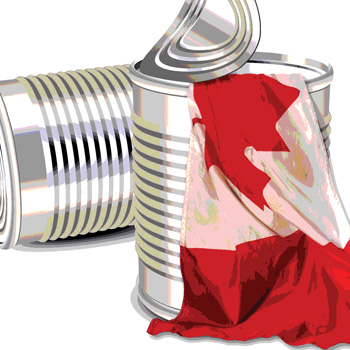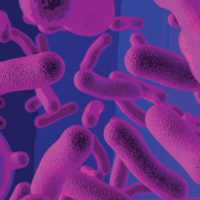Regulation of Food Packaging in Canada

The regulatory framework for packaging materials in Canada is established by the Canadian Food and Drugs Act (F&D Act) and the Food and Drug Regulations (FDRs). Section 4 of the F&D Act prohibits the sale of food that:
• Contains any poisonous or harmful substance
• Is unfit for human consumption
• Consists in whole or in part of any filthy, putrid, disgusting, rotten, decomposed or diseased animal or vegetable substance
• Is adulterated
• Was manufactured, prepared, preserved, packaged or stored under unsanitary conditions
The responsible agencies for food packaging regulations in Canada are Health Canada and the Canadian Food Inspection Agency (CFIA). The Health Products and Food Branch (HPFB) of Health Canada administers the F&D Act and FDRs, sets policies and standards for ensuring a safe food supply, conducts health risk assessments and advises CFIA on the safety of packaging materials. CFIA is responsible for inspection of food facilities and enforcement of the Canadian FDRs.
The Canadian FDRs include general safety requirements for food packaging in Section B.23.001, which state, “No person shall sell any food in a packaging that may yield to its contents any substance that may be injurious to the health of a consumer of the food.” The burden to ensure safety falls on the food seller.
In Section B.01.001 of the FDRs, a food additive is defined as “any substance the use of which results, or may reasonably be expected to result, in it or its by-products becoming a part of or affecting the characteristics of a food, but does not include…food packaging materials and components thereof.” Since food packaging materials are excluded from the definition of food additives, they are not subject to premarket clearance, except for packaging for infant formula and novel food.
A food package is defined as anything in which a food is wholly or partly contained, placed or packed under the F&D Act. This is broadly interpreted by Health Canada to include any article that contacts food during processing or distribution, or in retail establishments, including equipment, bulk food containers and transportation vehicles/vessels. Consumer products such as kitchen utensils, household food wrap and cookware are excluded because they are not tied to the sale of food products.
The FDRs restrict certain substances in food packaging. For example, Section B.23.003 prohibits the sale of any food in a package that has been manufactured from a polyvinyl chloride formulation containing an octyltin chemical.
Health Canada Review of Packaging Materials
While premarket clearance of packaging materials for most foods is not required in Canada, packaging material and component suppliers can, on a voluntary basis, request HPFB to issue a Letter of No Objection (LONO) regarding the safety of a material for use in food packaging applications. These letters do not constitute legal approval and do not relieve food sellers of their responsibilities. However, many food company customers require a LONO and, even when not required, these letters can be a valuable marketing tool.
LONOs are valid as long as the composition and intended use of the packaging material does not change. When these types of changes are made, manufacturers are required to notify HPFB. If a manufacture does not notify HPFB, the agency may rescind the material’s no-objection status.
Submissions to HPFB requesting LONOs are permitted for finished packaging materials or formulated products (Category 1), and for individual components of finished packaging materials (Category 2). Examples of Category 1 items are laminated films, containers, packaging resins and color concentrates; examples of Category 2 items include basic polymers, additives and pigments.
Submission for Category 1 items must contain information on:
1. The product identity, including its trade name, its structure, its complete composition, specifications, and chemical and physical properties relative to its intended use
2. The proposed use of the package, including the form in which the finished package will be used (i.e., bottle, film, etc.); its dimensions; the ratio of the weight of contacted food to unit area of packaging (g/in2); the time and temperature conditions under which the package will be exposed to food during packaging, distribution and use by consumers; and an estimate of projected market penetration
Other information that may be included, but not required, includes safety data sheets, technical data sheets, product literature and samples of the article. If the review reveals components that have not been evaluated by HPFB, a Category 2 submission on those components will be required. If a Category 2 submission for a component is required, the LONO for the formulated products or finished article will be placed on hold pending the completion of a safety assessment for that component.
The type of data required for a Category 2 submission—or one for single constituents/additives in packaging materials—is similar to what is required for a food contact notification submission in the U.S. These submissions must include:
• Information on the identity of the constituent/additive, including its chemical name, CAS number, molecular weight manufacturing information, purity, and physical and chemical properties
• Information on the proposed usage, including use level, types of food, temperature conditions and intended technical effects
• Migration data
• Toxicology data
Testing to determine migration or extraction data should be conducted under conditions that reflect as closely as possible those of the proposed end-use application. For aqueous, acidic and low-alcohol foods, 10 percent ethanol should be used as the simulant, whereas 95 percent ethanol should be used as the simulant for high-alcohol and fatty foods. Some other food simulants are also allowed, including distilled water, 3 percent acetic acid and heptane.
A tiered approach is used to determine toxicology data requirements based on levels of concern as determined by probable daily intake (PDI). The requirements, based on PDI levels, are:
• <0.025 µg/kg body weight (bw) – Below the threshold of toxicological concern
• 0.025 to 0.1 µg/kg bw – Structure-activity relationships
• 0.1 µg/kg bw to 2.5 µg/kg bw – Two genotoxicity studies (in vitro or in vivo) plus 28-day feeding study in rodents
• 2.5 to 25 µg/kg bw – Ninety-day feeding study, multigeneration study and teratology study, all in rodents
• 25 µg/kg bw – One-year feeding study in nonrodents and chronic toxicity/oncogenicity in two rodent species
The higher tiers require submission of all the data in the lower tiers as well, except that the 90-day study replaces the 28-day study. More information on submission requirements for food packaging material LONOs can be found on Health Canada’s website.[1]
While Canada does not have a positive list of cleared food packaging materials, as a service to industry, Health Canada maintains a list on its website of polymers that have received favorable LONOs. The list dates back to November 2003, but Health Canada will add pre-2003 polymers if a manufacturer requests them through a letter confirming the polymer formulation. The intent is to preclude the need for new submissions for LONOs in situations where interchanging one resin with a comparable one on the list is the only change made to the composition of a food packaging material. An additives list (similar to the polymer list) is under development, but its completion date has not been announced.
While LONOs are voluntary for most packaging materials in Canada, a LONO from Health Canada is required for packaging materials used in infant formula or novel process (i.e., high-pressure processing) under the FDRs.
Generally, packaging that complies with U.S. Food and Drug Administration (FDA) regulations will likely be deemed acceptable in Canada. However, compliance with FDA regulations alone is not sufficient for HPFB to accept a product. HPFB will complete an independent scientific review, using its own methods for estimating dietary exposure and determining whether the safety data are adequate.
CFIA Review of Food Packaging Materials
CFIA inspects federally registered facilities to ensure that packaging materials are suitable for their intended purpose and that they meet all Canadian regulatory requirements. In the past, packaging materials used in federally registered meat, fish and seafood processing facilities required premarket clearance from CFIA. However, an amendment to the Fish Inspection Regulations removed the premarket approval requirement for packaging materials in federally registered fish processing facilities in 2013. This year, the Canadian Meat Inspection Regulations were amended, effective July 2, 2014, to eliminate the premarket approval requirement for most packaging materials used in federally registered meat processing plants.
The 2014 amendment to the Meat Inspection Regulations did not eliminate the requirement for premarket clearance of processing aids for meats. Health Canada’s Bureau of Chemical Safety announced in October 2013, a new Policy Intent for Issuing an Interim LONO (iLONO) for Processing Aids. Under this policy, a petitioner requesting a LONO from Health Canada for a processing aid can also request that the submission be considered for an iLONO if the substance were identical in composition and intended use to one previously accepted as safe for food use by certain food regulatory agencies, including FDA. Once Health Canada receives a request for an iLONO, it will verify within 45 days if the submission meets the eligibility criteria. Conversely, HPFB does not have a statutory time frame for responding to requests for LONOs. The timeline depends on the complexity of the product (including toxicology), backlog of requests, and the quality and completeness of the information provided with the submission.
As a practical matter, a LONO request for a processing aid should be submitted to both HPFB and CFIA. Usually, though, CFIA will wait for HPFB to complete its evaluation. Both agencies will issue LONOs if they determine that the material/article is safe for the intended use. Importantly, while Canadian agencies share information, they will treat certain information from applicants and their suppliers as confidential—although the information should be claimed as such.
CFIA will continue to conduct inspections of federally registered facilities to ensure that packaging materials are suitable for their intended purpose and meet all Canadian regulatory requirements. A Q&A document on repealing the requirements for premarket registration of construction materials, packaging materials and nonfood chemicals lists three options that operators of federally registered meat establishments can use to demonstrate that these materials are safe and suitable for their intended purpose, and that they meet all regulatory requirements. These are:
• Previously issued CFIA letters of acceptance/no objection (i.e., the material is already listed on CFIA’s Reference Listing of Accepted Construction Materials, Packaged Materials and Non-Food Chemical Products)
• Letters of guarantee from suppliers/manufacturers
• A LONO from Health Canada or other references from Health Canada
If a Letter of Guaranty is used to demonstrate safety, inspectors will have the option to request additional supporting documentation if they have a reasonable doubt regarding the safety of the packaging material for its intended use. CFIA has indicated that an existing U.S. or European Union clearance could be used as supporting documentation to show safety.
The Reference Listing of Accepted Construction Materials, Packaged Materials, and Non-Food Chemical Products will be maintained on the CFIA website for approximately 2 years; however, it will no longer be updated.
Safe Food for Canadians Act
Canada’s Safe Food for Canadians Act (SFCA), which received Royal Assent in November 2012, consolidates the food provisions administered and enforced by CFIA of the Fish Inspection Act, the Canada Agricultural Products Act, the Meat Inspection Act and the Consumer Packaging and Labeling Act. The SFCA is intended to improve food safety oversight in Canada by providing a more consistent inspection approach across all food types; strengthening food traceability; improving control over imports; and increasing penalties and fines for violations.
On June 4, 2013, CFIA launched a consultation on its proposed regulatory framework to support the SFCA. In a discussion document on the regulatory framework, packaging is addressed in Annex 1, Section 1.2.1 on “Packaging Control.” The proposed regulatory requirements for packaging are:
• Handling and use of packaging ma-terials during processing is managed
• Packaging materials suitable for the intended purpose shall be used
• Contaminated, damaged or defective packaging materials shall not be used
Final publication of the regulations is expected at the end of 2014, with a target for implementation at the beginning of 2015. Once the SFCA is in force, two federal legislative regimes will apply to food in Canada: 1) the F&D Act and regulations, which apply to all food sold in Canada, and 2) the SFCA and regulations, which apply to food that is imported, exported or prepared for trade across provincial borders.
 George G. Misko is a partner in the Washington, DC, office of Keller and Heckman LLP. His practice focuses on food and drug matters, and environmental concerns, including pesticide regulation and chemical control regulations. He has extensive experience counseling clients on regulatory requirements relating to chemical substances, plastics and food products in the U.S. and other jurisdictions. He also represents trade associations, including acting as general counsel to the Global Silicones Council. Misko also has experience in civil trial and appellate matters. He can be reached at misko@khlaw.com.
George G. Misko is a partner in the Washington, DC, office of Keller and Heckman LLP. His practice focuses on food and drug matters, and environmental concerns, including pesticide regulation and chemical control regulations. He has extensive experience counseling clients on regulatory requirements relating to chemical substances, plastics and food products in the U.S. and other jurisdictions. He also represents trade associations, including acting as general counsel to the Global Silicones Council. Misko also has experience in civil trial and appellate matters. He can be reached at misko@khlaw.com.
References
1. www.hc-sc.gc.ca/fn-an/securit/packag-emball/index-eng.php.
Looking for a reprint of this article?
From high-res PDFs to custom plaques, order your copy today!








